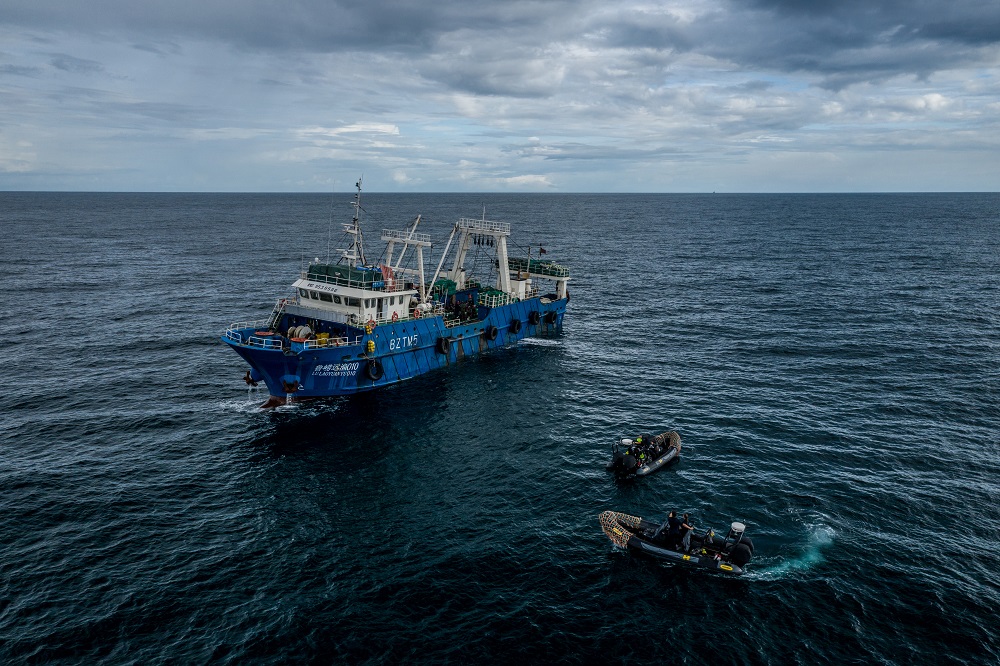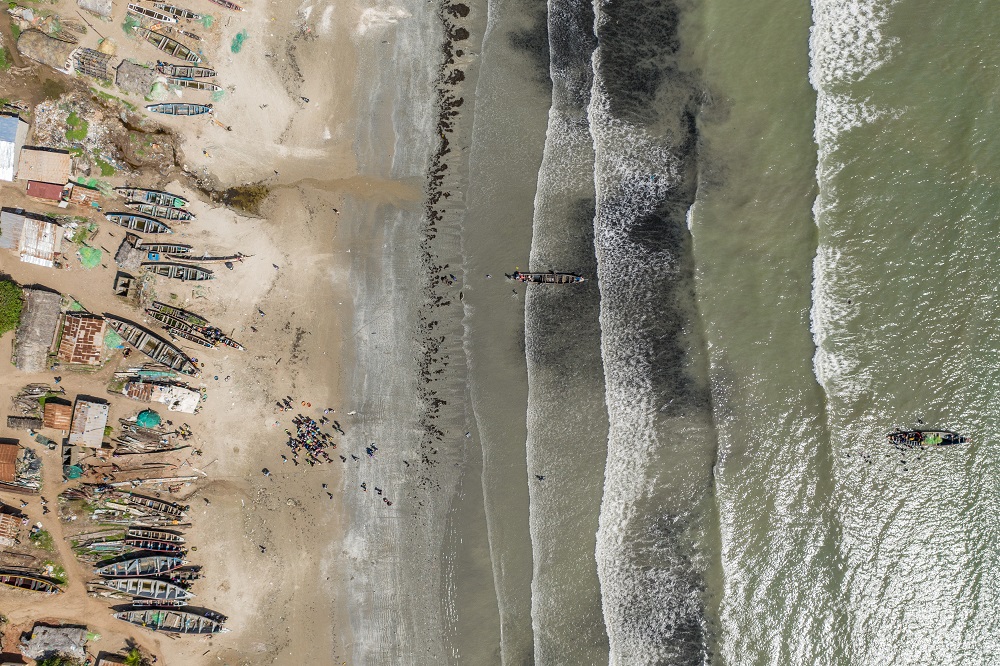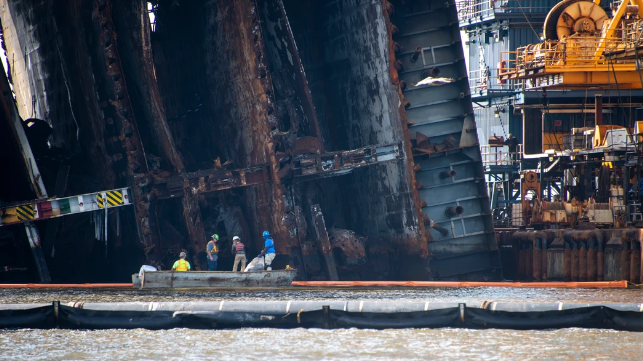Part II: Fish Farming is Feeding the World, But at What Cost?
[Part I of this article may be found here. This piece appeared first in The New Yorker and is reproduced here courtesy of The Outlaw Ocean Project.]
In September 2019, Gambian lawmakers gathered in the stately but neglected hall of the National Assembly for an annual meeting, where James Gomez, minister of the country’s fisheries and water resources, insisted that “Gambian fisheries are thriving. ” Industrial fishing boats and plants represent the largest employer of Gambians in the country, including hundreds of deckhands, factory workers, truck drivers, and industry regulators. When a lawmaker asked him about the criticisms of the three fish-meal plants, including their voracious consumption of bonga, Gomez refused to engage. “Boats are not taking more than a sustainable amount,” he said, adding that Gambian waters even have enough fish to sustain two more plants.
Under the best circumstances, estimating the health of a nation’s fish stock is a murky science. Marine researchers like to say that counting fish is like counting trees, except they’re mostly invisible—below the surface—and constantly moving. Ad Corten, a Dutch fishing biologist, told me that the task is even tougher in a place like West Africa, where countries lack the funding to properly analyze their stocks. The only reliable assessments of fish stocks in the area have focussed on Mauritania, Corten said, and they show a sharp decline driven by the fish-meal industry. “Gambia is the worst of them all,” he said, noting that the fisheries ministry barely tracks how many fish are caught by licensed ships, much less the unlicensed ones. As fish stocks have been depleted, many wealthier nations have increased their marine policing, often by stepping up port inspections, imposing steep fines for violations, and using satellites to spot illicit activity at sea. They also have required industrial boats to carry mandatory observers and to install monitoring devices onboard. But Gambia, like many poorer countries, has historically lacked the political will, technical skill, and financial capacity to exert its authority offshore.
Still, though it has no police boats of its own, Gambia is trying to better protect its waters. In August 2019, I joined a secret patrol that the fisheries agency was conducting with the help of an international ocean conservation group called Sea Shepherd, which had brought—as surreptitiously as it could—a one-hundred-and-eighty-four-foot ship called the Sam Simon into the area. It’s equipped with extra fuel capacity, to allow for long patrols, and a doubly reinforced steel hull for ramming into other boats.
In Gambia, the nine miles of water closest to the shore have been reserved for local fishermen, but on any given day dozens of foreign trawlers are visible from the beach. Sea Shepherd’s mission was to find and board trespassers, or other vessels engaged in prohibited behaviors, such as shark finning or netting juvenile fish. In the past few years, the group has worked with African governments in Gabon, Liberia, Tanzania, Benin, and Namibia to conduct similar patrols. Some fisheries experts have criticized these collaborations as publicity stunts, but they have led to the arrest of more than fifty illegal fishing ships.
Barely a dozen local government officials had been informed about the Sea Shepherd mission. To avoid being spotted by fishermen, the group brought in several small speed boats at night and used them to spirit a dozen heavily armed Gambian Navy and fisheries officers out to the Sam Simon. We were joined on the patrol by two gruff private-security contractors from Israel, who were training the Gambian officers in military procedures for boarding ships. While we waited on the moonlit deck, one of the Gambian guards, dressed in a crisp blue-and-white camouflage uniform, showed me a music video on his phone by one of Gambia’s best-known rappers, ST Brikama Boyo. He translated the lyrics of a song, called “Fuwareyaa,” which means “poverty”: “People like us don’t have meat and the Chinese have taken our sea from us in Gunjur and now we don’t have fish.”
Three hours after we embarked, the foreign ships had all but vanished, in what appeared to be a coördinated flight from the forbidden waters. Sensing that word about the operation had gotten out, the Sam Simon’s captain changed plans. Instead of focussing on the smaller unlicensed ships close to land that were mostly from neighboring African countries, he would conduct surprise at-sea inspections of the fifty-five industrial ships that were licensed to be in Gambian waters. It was a bold move: marine officers would be boarding larger, well-financed ships, many of them with political connections in China and Gambia.
Less than an hour later, we pulled alongside the Lu Lao Yuan Yu 010, a hundred-and-thirty-four-foot electric-blue trawler streaked with rust, operated by a Chinese company called Qingdao Tangfeng Ocean Fishery, a company that supplies all three of Gambia’s fish-meal plants. A team of eight Gambian officers from the Sam Simon boarded the ship, AK-47s slung over their shoulders. One officer was so nervous that he forgot the bullhorn he was assigned to carry. Another officer’s sunglasses fell into the sea as he leaped onto the deck.

Copyright Fabio Nascimento / The Outlaw Ocean Project
Onboard the Lu Lao Yuan Yu 010 were seven Chinese officers and a crew of four Gambians and thirty-five Senegalese. The Gambian marine officers soon began grilling the ship’s captain, a short man named Shenzhong Qui who wore a shirt smeared with fish guts. Below deck, ten African crew members in yellow gloves and stained smocks stood shoulder to shoulder on either side of a conveyor belt, sorting bonga, mackerel, and whitefish into pans. Nearby, the floor-to-ceiling rows of freezers were barely cold. Roaches scurried up the walls and across the floor, where some fish had been stepped on and squashed.
I spoke to one of the workers who told me his name was Lamin Jarju and agreed to step away from the line to talk. Though no one could hear us above the deafening ca-thunk, ca-thunk of the conveyor, he lowered his voice before explaining that the ship had been fishing within the nine-mile zone until the captain received a radioed warning from nearby ships that a policing effort was under way.
When I asked Jarju why he was willing to reveal the ship’s violation, he said, “Follow me.” He led me up two levels to the roof of the wheel room, where the captain works. He showed me a large nest of crumpled newspapers, clothing, and blankets, where, he said, several crew members had been sleeping for the past several weeks, ever since the captain hired more workers than the ship could accommodate. “They treat us like dogs,” Jarju said.
When I returned to the deck, an argument was escalating. A Gambian Navy lieutenant named Modou Jallow had discovered that the ship’s fishing log book was blank. All captains are required to maintain log books and keep detailed diaries that document where they go, how long they work, what gear they use, and what they catch. The lieutenant had issued an arrest order for the infraction and was yelling in Chinese at Captain Qui, who was incandescent with rage. “No one keeps that!” he shouted.
He was not wrong. Paperwork violations are common, especially on fishing boats working along the coast of West Africa, where countries don’t always provide clear guidance about their rules. Fishing-boat captains tend to view log books as tools of bribe-seeking bureaucrats or as statistical cudgels of conservationists bent on closing fishing grounds.
But the lack of proper logs makes it almost impossible to determine how quickly Gambia’s waters are being depleted. Scientists rely on biological surveys, scientific modelling and mandatory reports from fish dealers on shore to assess fish stocks. And they use log books to determine fishing locations, depths, dates, gear descriptions, and “fishing effort”—how long nets or lines are in the water relative to the quantity of fish caught.
Jallow ordered the fishing Captain to steer his ship back to port, and the argument moved from the upper deck down to the engine room, where the Captain claimed he needed a few hours to fix a pipe—enough time, the Sam Simon crew suspected, for the Captain to contact his bosses in China and ask them to call in a favor with high-level Gambian officials. Jallow, sensing a stalling tactic, smacked the Captain in the face. “You will make the fix in an hour!” Jallow shouted, grabbing the Captain by the throat. “And I will watch you do it.” Twenty minutes later, the Lu Lao Yuan Yu 010 was en route to shore.
Over the next several weeks, the Sam Simon inspected fourteen foreign ships, most of them Chinese and licensed to fish in Gambian waters, and arrested thirteen of them. Under arrest, ships are typically detained in port for several weeks and fined anywhere from five thousand to fifty thousand dollars. All but one vessel was charged with lacking a proper fishing-log book, and many were also fined for improper living conditions and for violating a law that stipulates Gambians must comprise twenty per cent of shipping crews on industrial vessels in national waters. On one Chinese-owned vessel, there weren’t enough boots for the deckhands, and one Senegalese worker was pricked by a catfish whisker while wearing flip flops. His swollen foot, oozing from the puncture wound, looked like a rotting eggplant. On another ship, eight workers slept in a space meant for two, a four-foot-tall steel-sided compartment directly above the engine room and dangerously hot. When high waves crashed onboard, the water flooded the makeshift cabin, where, the workers said, an electrical power strip had twice almost electrocuted them.
Back in Banjul, one rainy afternoon I sought out Manneh, the local Gambian journalist and environmental advocate. We met in the white-tiled lobby of the Laico Atlantic hotel, decorated with fake potted plants and thick yellow drapes. Pachelbel’s Canon played in an endless loop in the background, accompanied by the plinking of water dripping from the ceiling into half a dozen buckets. Manneh had recently returned to Gambia after a year in Cyprus, where he had fled after his father and brother had been arrested for political activism against Yahya Jammeh, a brutal autocrat who was eventually forced from power in 2017. Manneh, who told me that he hoped to become President one day, offered to take me to the Golden Lead factory.

Copyright Fabio Nascimento / The Outlaw Ocean Project
The next day, Manneh returned in a Toyota Corolla he had hired for the difficult drive. Most of the road from the hotel to Golden Lead was dirt, which recent rains had turned into a treacherous slalom course of deep and almost impassable craters. The trip was about thirty miles, and took nearly two hours. Over the din of a missing muffler, he prepared me for the visit. “Cameras away,” he cautioned. “No saying anything critical about fish meal.” Just a week before my arrival that some of the same fishermen who had pulled up the plant’s wastewater pipe had apparently switched sides, attacking a team of European researchers who had come to photograph the facility, pelting them with rocks and rotten fish. Though they opposed the dumping and resented the export of their fish, some locals did not want foreign media publicizing Gambia’s problems.
We finally pulled up at the entrance of the plant, five hundred yards from the beach, behind a ten-foot wall of white corrugated metal. An acrid stench, like burning orange peels and rotting meat, assaulted us as soon as we got out of the car. Between the factory and the beach was a muddy patch of land, studded with palm trees and strewn with litter, where fishermen were repairing their boats in thatched-roof huts. The day’s catch lay on a set of folding tables, where women were cleaning, smoking, and drying it for sale. One of the women wore a hijab dripping wet from the surf. When I asked her about the catch, she shot me a dour look and tipped her basket toward me. It was barely half-full. “We can’t compete,” she said. Pointing at the factory, she added, “It all goes there.”
The Golden Lead plant consists of several football-field-size concrete buildings, and sixteen silos, where dried fish meal and chemicals were stored. Fish meal is relatively simple to make, and the process is highly mechanized, which means that plants the size of Golden Lead need only about a dozen men on the floor at any given time. Video footage clandestinely taken by a fishmeal worker inside Golden Lead reveals the plant is cavernous, dusty, hot, and dark. Sweating profusely, several men shovel shiny heaps of bonga into a steel funnel. A conveyor belt carries the fish into a vat, where a giant churning screw grinds it into a gooey paste, and then into a long cylindrical oven, where oil is extracted from the goo. The remaining substance is pulverized into a fine powder and dumped onto the floor in the middle of the warehouse, where it accumulates into a ten-foot-tall golden mound. After the powder cools, workers shovel it into fifty-kilogram plastic sacks stacked floor to ceiling. A shipping container holds four hundred bags, and the men fill roughly twenty to forty containers a day.
Near the entrance of Golden Lead, a dozen or so young men hustled from shore to plant with baskets on their heads, brimming with bonga. Nearby, standing under several gangly palm trees, a forty-two-year-old fisherman named Ebrima Jallow explained that the women pay more for a single basket, but Golden Lead buys in bulk and often pays for twenty baskets in advance—in cash. “The women can’t do that,” he said.
A few hundred yards away, Dawda Jack Jabang, the fifty-seven-year-old owner of the Treehouse Lodge, a deserted beachfront hotel and restaurant, stood in a side courtyard staring at the breaking waves. “I spent two good years working on this place,” he told me. “And overnight Golden Lead destroyed my life.” Hotel bookings have plummeted, and the plant’s odor at times is so noxious that patrons leave his restaurant before finishing their meal.
Golden Lead has hurt more than helped the local economy, Jabang said. But what about all of those young men hauling their baskets of fish to the factory? Jabang waved the question away dismissively: “This is not the employment we want. They’re turning us into donkeys and monkeys.”
The COVID-19 pandemic has highlighted the tenuousness of this employment landscape, as well as its corruption. In May, many of the migrant workers on fishing crews returned home to celebrate Eid just as borders were closing down. With workers unable to return to Gambia and new lockdown measures in place, Golden Lead and other plants suspended operation.
Or they were supposed to. Manneh obtained secret recordings in which Bamba Banja, of the Ministry of Fisheries, discussed bribes in exchange for allowing factories to operate during the lockdown. In October, Banja took a leave of absence after a police investigation found that, between 2018 and 2020, he had accepted ten thousand dollars in bribes from Chinese fisherman and companies, including Golden Lead.
On the day that I visited Golden Lead, I made my way down to the sprawling beach. I found Golden Lead’s new wastewater pipe, which was about 12 inches in diameter, already rusted, corroded and only slightly visible above the mounds of sand. The Chinese flag was gone. Kneeling down, I felt liquid flowing through it. Within minutes, a Gambian guard appeared and ordered me to leave the area.
The next day I headed to the country’s only international airport, located an hour away from the capital, Banjul, to catch my flight home. My luggage was light now that I’d thrown away the putrid-smelling clothes from my trip to the fish-meal plant. At one point during the drive, as we negotiated pothole after pothole, my taxi driver vented his frustration. “This,” he said, gesturing ahead of us, “is the road the fishmeal plant promised to pave.”
At the airport, I discovered my flight had been delayed by a flock of buzzards and gulls blocking the only runway. Several years earlier, the Gambian government had built a landfill close by, and scavenger birds descended in droves. While I waited among a dozen German and Australian tourists, I called Mustapha Manneh. I reached him at home, in the town of Kartong, seven miles from Gunjur.
Manneh told me he was standing in his front yard, looking out on a litter-strewn highway that connects the JXYG factory, a Chinese fish-meal plant, to Gambia’s largest port, in Banjul. In the few minutes we had been talking, he said, he had watched ten tractor-trailer trucks rattle by, kicking up thick clouds of dust as they went, each hauling a forty-foot-long shipping container full of fish meal. From Banjul, those containers would depart for Asia, Europe, and the United States.
“Every day,” Manneh said, “it’s more.”
Ian Urbina is the director of The Outlaw Ocean Project, a non-profit journalism organization based in Washington DC that focuses on environmental and human rights concerns at sea globally.
This article appears here courtesy of The Outlaw Ocean Project. Part I of this story may be found here.






